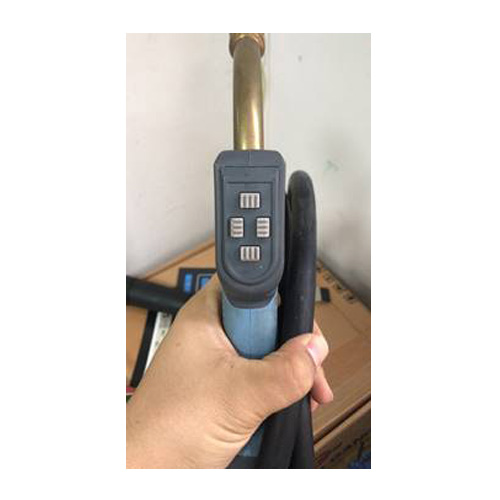Availability and delivery date contact us for more information.
This device has two different levels of current as its power source.
On the one hand, the constant base current, which maintains the welding arc, with the pulse current over it.
The built-in processor ensures that the drops of additive material melt down, always 1 drop per pulse.
You have a second choice setting with the double pulse setting.
The device will then pulse the welding wire.
The big advantage of pulse welding is that less heat is introduced, which minimizes the deformation of the material.
You will also obtain an optimal penetration, which is expressed in a visually perfect weld seam with good adhesion, you will also notice that the spatter behavior is nil.
The welding itself becomes a lot easier, especially on thin material when welding in an upward or downward position.
Our DP-350 Magster is particularly suitable for welding aluminum.
Welding on Alu plate even below 1 mm, with welding wire of 1.2 is perfectly possible, even for longer weld seams.
This machine is often an alternative to Tig welding with an ACDC, especially because you will be able to weld 4 times faster on average, and especially for less qualified welders.
For an even better result, this device is equipped with a fully synergic setting.
It suffices to enter the parameters in 5 available languages, including Dutch.
The software is written by the Vienna University of Technology, which is a leader in welding applications.
In addition to the synergic setting, the user has the option to set his own parameters.
This program can then be saved for a similar next welding task.
On videos you can see how the single and double pulse works, and what the achieved result is.
In contrast to the market price, this extremely full-fledged double pulse welding machine is very affordable.

V: Hello Jan,
I have a new customer who wants to buy several welding machines in the coming years.
They currently have a Lorch M-PRO 300.
Now they are shocked by the price difference between the Lorch and the Javac, they are a bit suspicious about that.
Can you give an explanation for that?
The customer wanted a response from the manufacturer (that is, you) about that price difference.
They generally only attach with the device.
They would also like to try one for a month, is that something for us together?
Thanks in advance for your response
Kind regards,
Bas Crooijmans
A: Bas,
Well what can I answer to this, Lorch is a German device, so is ours, but the fact that our price is now considerably cheaper has to do with the fact that the price is under pressure in Germany, there are numerous providers on the internet that offer devices to coast and to offer color, usually without any knowledge and service.
It is the policy of Javac Germany.
To answer this by coming up with an aggressive price.
If you ask me, the “normal” market value is noticeably higher for the Magstar 315.
If we look at it technically, I would even dare to say that our machine is superior to the M pro 300…
Unlike the Lorch, our machine is equipped with an inverter, while at Lorch this is still a transformer, with 21 steps.
I deduce this from their presentation on their site, while the control knob for the power reminds me more of a stepless regulation.
Maybe they have built in some kind of chopper, I don’t know their product that well, but I go by the weight and the ED, and for me this is still an old generation with transfo.
Note that power consumption is disproportionately high with this old transformer, and certainly if one will soon be tackled on peak powers, as this will happen in Belgium in 2022, I don’t know for NL, but it will also come (ref electrification of the fleet ).
Especially when spot welding (bonding) an inverter is much more economical with the current, a transformer always builds up a peak voltage unless Lorch has found something with their “tiptronic”.
What I also find strange is that our 315 AMP has 60% ED at 40°C ambient temperature, while with Lorch this is clearly lower with the 205 AMP.
With only 25% at full power.
I would say this is a lightweight rather than a PRO-M.
in other words a magster 250 would suffice for the same job.
The weight is also a strange story, in my previous life when I sold the very good Bester machines (Now Lincoln) was a 315 AMP in a weight class of 130 kg.
This Lorch weighs only 80 kg, for stitching this machine is sufficient, but I would like to see the result with solid wire SG 1.2
Then our Lorch quickly goes to the side at 300 AMP to blow out, while the Javac calmly steams on.
For the rest, the parameters are about the same.
I agree that they test a device for 1 week, 1 month is absolutely not necessary. A little welder will already know this after his first roll of welding wire, and this really doesn’t take a month, at least not with an active company.
Regards, Jan (Javac)
Video Single Pulse
Video Double Pulse
There are currently no reviews.